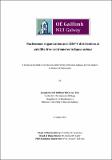| dc.contributor.advisor | Sullivan, Kevin F. | |
| dc.contributor.author | McCarter, Joseph Gerald William | |
| dc.date.accessioned | 2017-02-21T15:29:01Z | |
| dc.date.issued | 2017-02-15 | |
| dc.identifier.uri | http://hdl.handle.net/10379/6329 | |
| dc.description.abstract | Centromeres are distinct epigenetic loci present in single copy per chromosome. Defined by the presence of the histone H3 variant CENP-A, centromeres play a vital role in chromosome segregation via the kinetochore and mitotic apparatus. CENP- C plays an important role in CENP-A deposition onto chromatin and acts as a primary anchor between the centromeric chromatin and kinetochore interface. Due to the typical association of centromeres with arrays of repetitive satellite DNA, chromatin profiling using next generation sequencing methods remains quite challenging and the subunit organization of centromeres at a molecular level is unclear. We present our analysis, which identified a system of naturally occurring satellite-free centromeres in Equus asinus – the domestic donkey. Using a ChIP-seq approach, donkey skin fibroblasts were processed using antibodies against CENP- A and CENP-C, revealing sixteen centromeres in the donkey genome that are not associated with classical satellite DNA sequences but rather are formed at satellite- free sequence domains. The sixteen centromere domains identified were shown to contain very comparable amounts of CENP-A and CENP-C at each centromere despite the genomic footprint occupied by the domains. In this study, we also present our analysis of the transmission of CENP-A domains from parents to offspring, giving more insight into the plasticity of centromeres. A native ChIP-seq approach has also been carried out to investigate nucleosome distribution across these centromere domains. Collectively, this study provides more insight into centromere structure and nucleosome organisation and strongly supports equids as a model system to study centromere behavior. | en_IE |
| dc.rights | Attribution-NonCommercial-NoDerivs 3.0 Ireland | |
| dc.rights.uri | https://creativecommons.org/licenses/by-nc-nd/3.0/ie/ | |
| dc.subject | Centromere | en_IE |
| dc.subject | CENP-A | en_IE |
| dc.subject | CENP-C | en_IE |
| dc.subject | ChIP-seq | en_IE |
| dc.subject | Chromatin | en_IE |
| dc.subject | Biochemistry | en_IE |
| dc.title | Nucleosome organisation and CENP-C distribution at satellite-free centromeres in Equus asinus | en_IE |
| dc.type | Thesis | en_IE |
| dc.contributor.funder | PRTLI | en_IE |
| dc.contributor.funder | SFI | en_IE |
| dc.local.note | Centromeres are the genetic loci that direct chromosome movement during cell division. The unique centromeric DNA sequences of the domestic donkey, Equus asinus, allowed investigation of the molecular architecture of mammalian centromeric chromatin. Two key proteins, CENP-A and CENP-C, have been mapped, revealing the foundation architecture of the centromere. | en_IE |
| dc.description.embargo | 2019-02-07 | |
| dc.local.final | Yes | en_IE |
| nui.item.downloads | 45 | |


